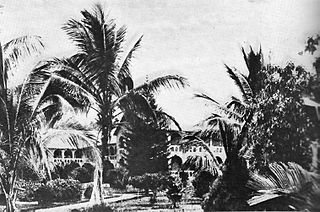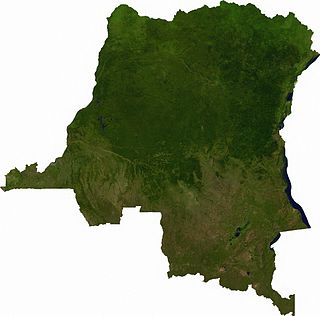| ||
Abbreviations : Kal. (Kalamu), Kin. (Kinshasa), K.-V. (Kasa-Vubu), Ling. (Lingwala), Ng.-Ng. (Ngiri-Ngiri) |
The city-province (ville-province in French) of Kinshasa is divided into 24 communes.
| ||
Abbreviations : Kal. (Kalamu), Kin. (Kinshasa), K.-V. (Kasa-Vubu), Ling. (Lingwala), Ng.-Ng. (Ngiri-Ngiri) |
The city-province (ville-province in French) of Kinshasa is divided into 24 communes.
| Commune | District | Land area | Inhabitants (2004) | Density |
|---|---|---|---|---|
| Bandalungwa | Funa | 6.82 km2 (2.63 sq mi) | 202,341 | 29,669/km2 (76,840/sq mi) |
| Barumbu | Lukunga | 4.72 km2 (1.82 sq mi) | 150,319 | 31,847/km2 (82,480/sq mi) |
| Bumbu | Funa | 5.3 km2 (2.0 sq mi) | 329,234 | 62,120/km2 (160,900/sq mi) |
| Gombe | Lukunga | 29.33 km2 (11.32 sq mi) | 32,373 | 1,104/km2 (2,860/sq mi) |
| Kalamu | Funa | 6.64 km2 (2.56 sq mi) | 315,342 | 47,491/km2 (123,000/sq mi) |
| Kasa-Vubu | Funa | 5.05 km2 (1.95 sq mi) | 157,320 | 31,152/km2 (80,680/sq mi) |
| Kimbanseke | Tshangu | 237.78 km2 (91.81 sq mi) | 946,372 | 3,980/km2 (10,300/sq mi) |
| Kinshasa | Lukunga | 2.87 km2 (1.11 sq mi) | 164,857 | 57,441/km2 (148,770/sq mi) |
| Kintambo | Lukunga | 2.72 km2 (1.05 sq mi) | 106,772 | 39,254/km2 (101,670/sq mi) |
| Kisenso | Mont Amba | 16.6 km2 (6.4 sq mi) | 386,151 | 23,262/km2 (60,250/sq mi) |
| Lemba | Mont Amba | 23.70 km2 (9.15 sq mi) | 349,838 | 14,761/km2 (38,230/sq mi) |
| Limete | Mont Amba | 67.6 km2 (26.1 sq mi) | 375,726 | 5,558/km2 (14,400/sq mi) |
| Lingwala | Lukunga | 2.88 km2 (1.11 sq mi) | 94,635 | 32,859/km2 (85,100/sq mi) |
| Makala | Funa | 5.6 km2 (2.2 sq mi) | 253,844 | 45,329/km2 (117,400/sq mi) |
| Maluku | Tshangu | 7,948.8 km2 (3,069.0 sq mi) | 179,648 | 23/km2 (60/sq mi) |
| Masina | Tshangu | 69.93 km2 (27.00 sq mi) | 485,167 | 6,938/km2 (17,970/sq mi) |
| Matete | Mont Amba | 4.88 km2 (1.88 sq mi) | 268,781 | 55,078/km2 (142,650/sq mi) |
| Mont Ngafula | Lukunga | 358.92 km2 (138.58 sq mi) | 261,004 | 727/km2 (1,880/sq mi) |
| Ndjili (N'Djili) | Tshangu | 11.4 km2 (4.4 sq mi) | 442,138 | 38,784/km2 (100,450/sq mi) |
| Ngaba | Mont Amba | 4.0 km2 (1.54 sq mi) | 180,650 | 45,163/km2 (116,970/sq mi) |
| Ngaliema | Lukunga | 224.3 km2 (86.60 sq mi) | 683,135 | 3,046/km2 (7,890/sq mi) |
| Ngiri-Ngiri | Funa | 3.4 km2 (1.31 sq mi) | 174,843 | 51,424/km2 (133,190/sq mi) |
| Nsele (N'Sele) | Tshangu | 898.79 km2 (347.02 sq mi) | 140,929 | 157/km2 (410/sq mi) |
| Selembao | Funa | 23.18 km2 (8.95 sq mi) | 335,581 | 14,477/km2 (37,500/sq mi) |
| City-Province of Kinshasa | 9,965.21 km2 (3,847.59 sq mi) | 7,196,648 | 722.18/km2 (1,870.4/sq mi) |
Source : Institut National de la Statistique (INS)

Politics of the Democratic Republic of Congo take place in a framework of a republic in transition from a civil war to a semi-presidential republic.

Ground transport in the Democratic Republic of the Congo (DRC) has always been difficult. The terrain and climate of the Congo Basin present serious barriers to road and rail construction, and the distances are enormous across this vast country. Furthermore, chronic economic mismanagement and internal conflict has led to serious under-investment over many years.

Kinshasa is the capital and largest city of the Democratic Republic of the Congo. Once a site of fishing and trading villages along the Congo River, Kinshasa is now one of the world's fastest-growing megacities. With an estimated population of 16 million residents, it's the most densely populated city in the DRC and the second most populated city in Africa. Parenthetically, it is Africa's third-largest metropolitan area and the leading economic, political, and cultural center of the DRC. Often described as the "economic giant of Central Africa," it houses numerous industries, including manufacturing, banking, telecommunications, and entertainment. Incidentally, the city also hosts some of DRC's significant institutional buildings, such as the Palais du Peuple, Palais de la Nation, Court of Cassation, Constitutional Court, Cité de l'Union Africaine, Palais de Marbre, Stade des Martyrs, and multiple federal departments and agencies.
Maluku may refer to:

Bandundu is one of eleven former provinces of the Democratic Republic of the Congo. It bordered the provinces of Kinshasa and Bas-Congo to the west, Équateur to the north, and Kasai-Occidental to the east. The provincial capital is also called Bandundu.

Nangarhār also called Nangrahar or Ningrahar, is one of the 34 provinces of Afghanistan, located in the eastern part of the country and bordering Logar, Kabul, Laghman and Kunar provinces as well as having an international border with Pakistan. It is divided into 22 districts and has a population of about 1,735,531, the third highest of the country's 34 provinces. The city of Jalalabad is the capital of Nangarhar province. Nangarhar province is famous for fish and karaye, and the popular tourist locations Daroonta and Pul-e- Sayad.

Kisantu, is a town in the western Democratic Republic of Congo, lying south west of Kinshasa, on the Inkisi River. It is known for its large cathedral and for its botanical gardens, which include an arboretum of indigenous trees.

Équateur is one of the 21 new provinces of the Democratic Republic of the Congo created in the 2015 repartitioning. Équateur, Mongala, Nord-Ubangi, Sud-Ubangi, and Tshuapa provinces are the result of the dismemberment of the former Équateur province. The new province was formed from the Équateur district and the independently administered city of Mbandaka which retained its status as a provincial capital.

Gombe, also known as La Gombe, is one of the 24 communes that are the administrative divisions of Kinshasa, the capital city of the Democratic Republic of the Congo (DRC). Formerly referred to as Kalina, the name originated from Lieutenant E. Kallina, an Austro-Hungarian soldier who volunteered in the Independent State of the Congo. Encompassing a vast area of approximately 29.33 square kilometers, it is home to an approximate population of 49,024 residents.

Article 2 of the Constitution of the Democratic Republic of the Congo divides the country into the capital city of Kinshasa and 25 named provinces. It also gives the capital the status of a province. Therefore, in many contexts Kinshasa is regarded as the 26th province.

Articles related to the Democratic Republic of the Congo include:

The Archdiocese of Kinshasa is an archdiocese of the Roman Catholic Church in the Democratic Republic of the Congo. Its ecclesiastic territory includes the capital city of Kinshasa and surrounding districts. The archdiocese is the metropolitan see for the Ecclesiastical Province of Kinshasa. The current archbishop is Fridolin Ambongo Besungu.
Ghislain ChikezDiemu is a politician in the Democratic Republic of the Congo, and a member of the People's Party for Reconstruction and Democracy, of which he was previously Secretary General. He joined the AFDL in 1997 and was appointed Vice-Minister of the Interior by Joseph Kabila, and later on, Secretary General of the PPRD.
The Province of the Anglican Church of the Congo is a province of the Anglican Communion, stretching over the Democratic Republic of the Congo and the Republic of the Congo.
Emile Christophe Mota Ndango is the former minister of Agriculture, livestock and fishery of the Democratic Republic of Congo. He is also the acting president of Regional Fisheries Commission of the Gulf of Guinea, COREP. He is also a member of the national parliament of the Democratic Republic of the Congo. and the former chief of cabinet of the late president of the Congo, Laurent-Désiré Kabila. He was born on the 5 May 1956 in the Katanga province.
The Presbyterian Community in Kinshasa was founded in 1955 in Leopoldville by the American Presbyterian Congo Mission. The church was involved in the Protestant ecumenical movements, in the Church of Christ in Congo. The church was divided because of theological issues and 1,500 members withdrew to Pentecostal churches. In 1995 the church had 40,000 communicant members, 10,000 youth and 86 active pastors. The church has partnership relations with the Presbyterian Church (USA). The denomination had 70,000 members and 74 congregations and 152 house fellowships in 2004. The church is a member of the World Communion of Reformed Churches.
Bestine Kazadi Ditabala,, is a Congolese writer.

Mongala District was a district of the Belgian Congo and the Democratic Republic of the Congo. It went through various changes in extent. It covered roughly the same area as the present Mongala province and most of Nord-Ubangi province.

Democratic Republic of the Congo–India relations are the international relations that exist between the Democratic Republic of the Congo (DRC) and India.